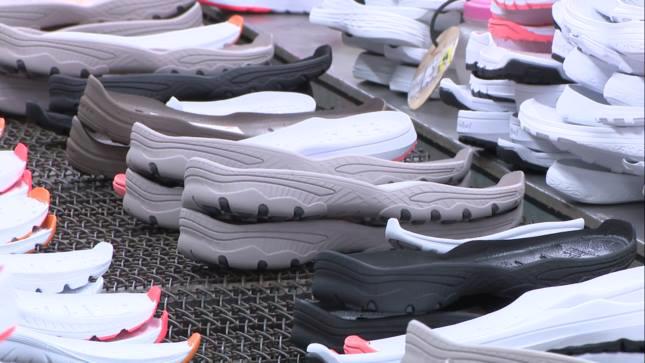Mr. Nguyen Duc Thuan, Chairman of the Vietnam Leather, Footwear and Handbag Association (LEFASO), outlined these challenges at the opening of the 41st International Footwear Conference (CIFA 41) held on July 9, 2024, in Ho Chi Minh City.
On this occasion, Mr. Thuan called on businesses and associations to strengthen cooperation and create timely and effective connections to stabilize the supply chain, aiming for green and sustainable development.
GLOBAL SUPPLY CHAIN CHALLENGES
Decision No. 1643/QD-TTg dated December 29, 2022, of the Prime Minister approving the Strategy for the Development of Vietnam’s Textile, Garment, Leatherette, and Footwear Industries until 2030, with a vision to 2035, identifies footwear as a key export industry for the nation, with competitive and high-quality products in the global market, meeting the needs of the domestic market, and maintaining its second position in the world.
Vietnam is currently a leading global manufacturer and exporter of footwear. According to LEFASO statistics, Vietnam ranks third in the world in footwear production (after China and India) with 1.3 billion pairs per year, accounting for 5.4% market share, and second in footwear exports (after China) with 1.276 billion pairs per year, accounting for 7.3% market share.
Vietnam’s footwear industry was severely impacted by the Covid-19 pandemic but has gradually recovered and regained its “powerhouse” status over the past year. In 2023, despite numerous challenges in the global and domestic economies, Vietnam’s footwear and handbag industries remained resilient, achieving an export turnover of more than USD 24 billion.
In 2024, the Vietnamese footwear and handbag industries are expected to follow two scenarios.
Optimistic scenario: Export turnover reaches USD 27 billion, a 10% increase.
Moderate scenario: Export turnover reaches USD 25.6 billion, a 6% increase compared to 2023.
Speaking at the conference, Deputy Minister of Industry and Trade Phan Thi Thang stated that the government and the Ministry of Industry and Trade expected that by 2030, the total export turnover of footwear and handbags in Vietnam would reach USD 38-40 billion. By 2035, the industry will develop efficiently and sustainably following a circular economic model, completing the domestic value chain and effectively participating in the global value chain, while also developing some regional and global brands.

However, like some other specific industries, the footwear industry heavily relies on raw materials and supply chains. The disruption in the supply chain during the Covid-19 pandemic led to a halt in production due to a lack of or severe shortage of raw materials.
Acknowledging the challenges faced by the global footwear supply chain, Allen Lai, Secretary-General of CIFA, pointed out issues related to tariffs in import and export markets, digital transformation, technology innovation, and production processes, which have become significant barriers for businesses and associations in the footwear industry, in addition to the scarcity of raw materials, human resources, high production costs, and logistics services.
RESTRUCTURING AND GREEN TRANSITION FOR SUSTAINABLE DEVELOPMENT
The footwear, leather, and handbag industries in Vietnam have significant potential and opportunities for development. However, the global trend towards “greening” is becoming increasingly stringent for businesses, especially exporters. For the footwear industry, the pressure to go green is immense, as textiles and footwear are the second most polluting industry in the world.
Currently, Asia is considered the world’s largest center for footwear production, exports, and consumption. Specifically, out of the top 10 footwear-producing countries and territories, eight are from Asia, with the top four being China, India, Vietnam, and Indonesia. Similarly, among the top 10 footwear-exporting countries, five are from Asia: China, Vietnam, Indonesia, Turkey, and Cambodia.
Although none of the top 10 footwear-importing countries are from Asia, the region’s domestic consumption is substantial, with India and China being notable examples. According to Indian footwear manufacturers, their current supply is only 2.5 billion pairs per year, while the domestic demand of this second most populous country in the world can reach up to 6 billion pairs. Therefore, the Indian government has introduced several incentive policies to attract investment. Manufacturers in Asia need to collaborate and cooperate to form a collective strength.
Similarly, China produces over 13 billion pairs per year, exports 9 billion pairs, and consumes about 4 billion pairs domestically. In contrast, Vietnam produces 1.3 billion pairs and exports 2.7 billion pairs, indicating that domestic consumption in Vietnam is still modest, and there is considerable potential and room for growth.

The green transition for sustainable development is not only a global trend but also a mandatory requirement for businesses, especially those in the footwear industry. It also presents an opportunity for Vietnamese footwear brands to enhance their value and competitiveness in the international market.
Mr. Nguyen Duc Thuan, Chairman of TBS Group and CIFA 41-2024, affirmed: “Footwear businesses cannot stay on the sidelines of the 4.0 revolution. They must adopt automation, artificial intelligence (AI), and green development in their production lines or risk being excluded from the global supply chain.”
To achieve this, Mr. Thuan suggested that research and development in design, raw materials, auxiliary materials, investment in technology applications, and distribution and sales channels need to change, focusing on quality, aesthetics, cost reduction, CO2 emissions reduction, and ultimately serving the end consumers.
China, the world’s leading exporter of footwear and raw materials for the footwear industry, also has specialized research centers for this sector. Therefore, the Ministry of Industry and Trade recommended that LEFASO and its member companies invest in establishing research and development centers for raw and auxiliary materials and design, following the models of China and other advanced countries, to promote sustainable development in Vietnam’s footwear, leather, and handbag industries.
According to LEFASO, in the first six months of 2024, the export turnover of Vietnam’s footwear and handbag industries was estimated at over USD 6.5 billion, a 5.7% increase compared to the same period last year. In 2024, export turnover is expected to reach approximately USD 25.5-27 billion, significantly contributing to the country’s total export turnover and GDP.
Export of agricultural, forestry, and aquatic products increases by over 79%
According to the Ministry of Agriculture and Rural Development, in January 2024, the total export turnover of agriculture, forestry, and fisheries reached $5.14 billion, a 79.2% increase compared to the same period last year; while the import value was $3.72 billion. Therefore, the agriculture, forestry, and fisheries sector achieved a trade surplus of over $1.4 billion in the first month of 2024, a more than 4.6-fold increase compared to the same period last year.
Processing and Manufacturing Industry: The Key Drive for Export Success
In January 2024, the export of processed and manufactured industrial goods continues to hold the leading position in the country’s total export turnover.














